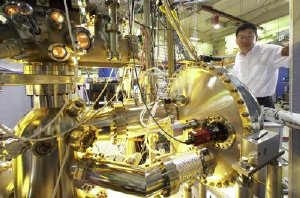Dec 17 2009
Zhi-Xun Shen, director of the Stanford Institute for Materials and Energy Science, or SIMES, a joint institute of the Department of Energy's SLAC National Accelerator Laboratory and Stanford University, has been awarded the Ernest Orlando Lawrence Award by the U.S. Department of Energy. Shen, who received the prize for his pioneering work in materials science, is among six other distinguished awardees, announced on December 16, 2009.
 This is Zhi-Xun Shen of DOE/SLAC National Accelerator Laboratory and Stanford University. Credit: Image courtesy of Peter Ginter/SLAC.
This is Zhi-Xun Shen of DOE/SLAC National Accelerator Laboratory and Stanford University. Credit: Image courtesy of Peter Ginter/SLAC.
"The contributions made by these researchers to advance the national, economic and energy security of the United States are wide-ranging and meaningful," Secretary of Energy Steven Chu said. "I congratulate the winners and look forward to their discoveries still to come."
One of the highest scientific honors that is bestowed by the U.S. government, recipients of the E.O. Lawrence award receive citations signed by the Secretary, a gold medal bearing the likeness of the award's namesake, Ernest Orlando Lawrence, and a $50,000 honorarium.
Shen's citation reads, "For his ground breaking discoveries and pioneering use of high resolution angle-resolved photoemission to advance understanding of strongly correlated electron systems including high-transition temperature superconductors and other complex oxides."
"Z.-X.'s accomplishments truly fit the spirit of this award," said SLAC Director Persis Drell. "In addition to providing leadership in the fields of materials and energy research, Z.-X. is also tirelessly dedicated to the encouragement of young scientists. We are privileged to have him on our faculty."
Shen completed his PhD work at Stanford in 1989 and is currently the Paul Pigott Professor of Physical Sciences in the departments of Physics and Applied Physics at Stanford University, and a professor of Photon Science at SLAC. He became director of the X-Ray Laboratory for Advanced Materials, or XLAM, in 2006, and remained director when XLAM became SIMES in 2008. A unique multi-disciplinary institute engaged in both theory and experiment, SIMES aims to understand and develop complex and novel materials to serve as the basis for new clean and economical energy sources and other important technologies.
"SIMES did not exist until Z.-X. pushed forward with creating it," said Stanford Dean of Research Ann Arvin. "Now it is a state-of-the-art program at the frontier of energy research that is dedicated to promoting scientific and technological innovation."
Shen's research has focused on strongly correlated materials made from transition metal oxides. These materials have unique properties, such as high temperature superconductivity and colossal magnetoresistance, which are not describable in terms of the behavior of individual electrons. Shen made a major breakthrough when he showed that studying these materials under synchrotron X-ray light could begin to reveal the important and unexpected underlying physics and symmetry behind superconductivity, which has widespread applications in power transmission technology, accelerator technology, medical imaging devices and microwave technology.
Since then, Shen has contributed greatly to a general understanding of the physics of these materials. He has published more than 250 papers in his career thus far, several of which are considered seminal in the field. He has also trained a large number of young researchers, including more than twenty who are now on the faculties and staff of research universities and national laboratories.
"Z.-X. has generated a massive body of work, but it's not just the sheer number of papers that is important," said Tom Devereaux, a SIMES group manager. "He has published work which established anchor points in our understanding of materials science; papers that make the whole field stop and reconsider the way we think about things and the direction in which we are headed."
"I am thrilled to receive this recognition," said Shen. "It was the Stanford and SLAC environment that made it possible for me to do the kind of research I am doing. I am very happy about that."